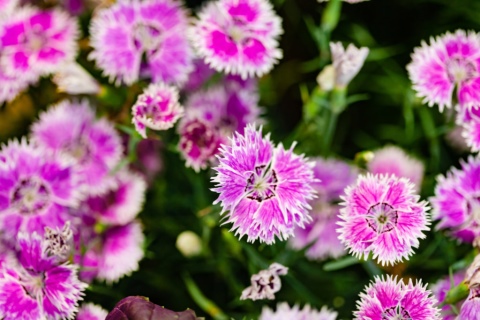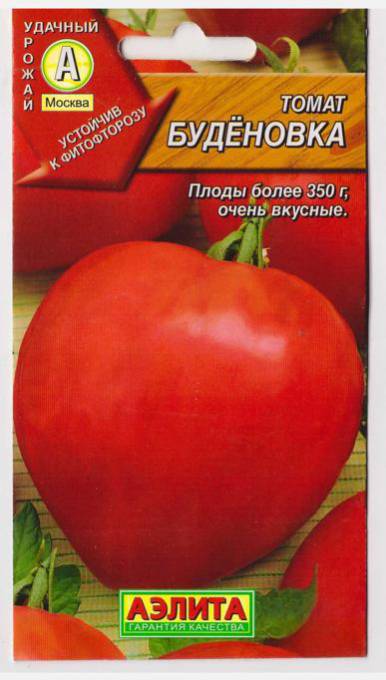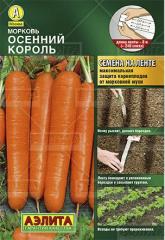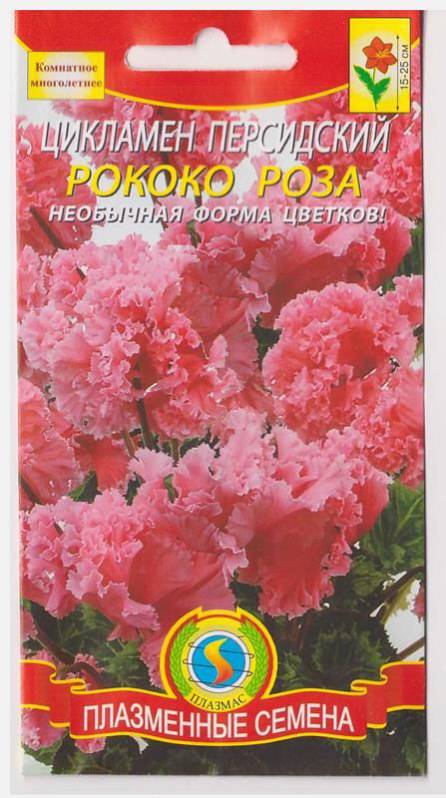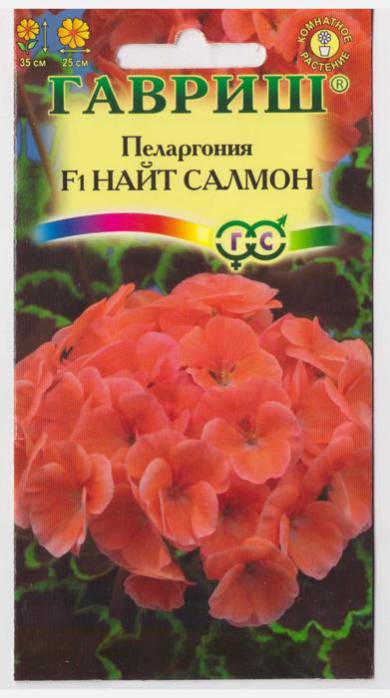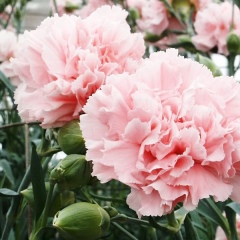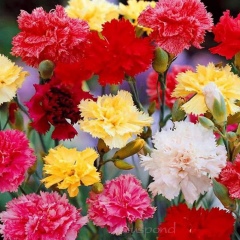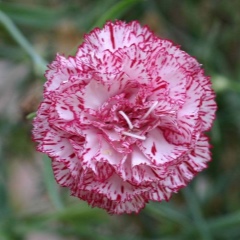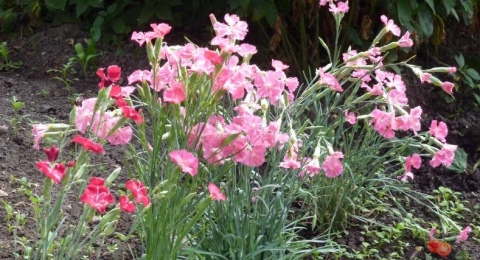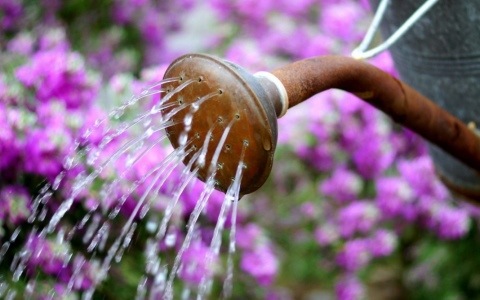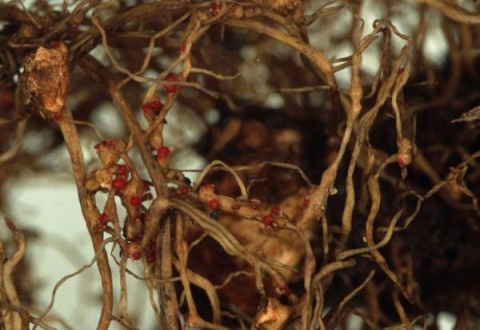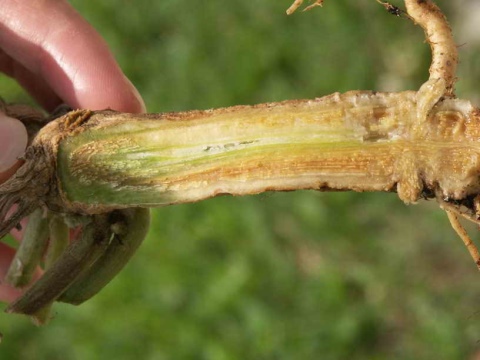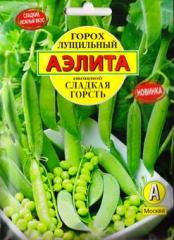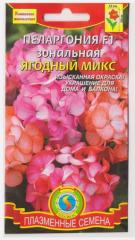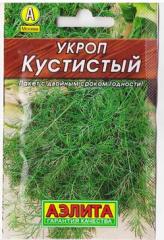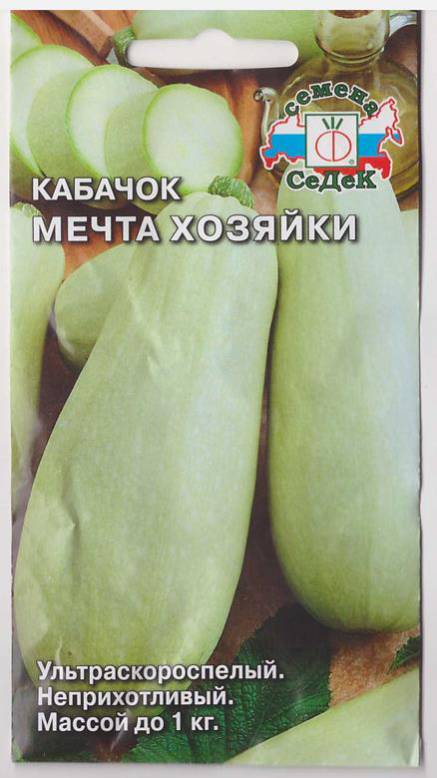How to grow a Grenadine carnation?
Cultivation of Grenadine carnations from seeds can be carried out both by seedlings and directly in the open field. But in any case, the following features must be taken into account:
- The plant is drought-resistant, and therefore feels great in open, well-lit areas. It can grow in shaded areas, but in this case, the flower should receive at least 6 hours of natural light every day.
- The soil likes water-permeable and does not tolerate stagnant moisture. At the same time, it is good if the soil is nutritious and light. It grows poorly in cold and heavy clay soils. During a thaw due to excess water, the Grenadine carnation can die, so it is better to place it on a slope.
- In order for the seeds to sprout and the seedlings to take root well, it is advisable to add organic matter to the soil: humus, manure or compost. If the substrate is characterized by high acidity, ash is additionally added to it or liming is carried out.
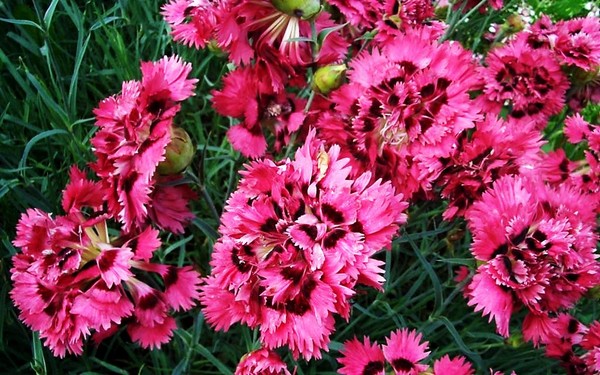
Seedling method of growing
As we have already said, in our latitudes, the Grenadine carnation is cultivated as a biennial. In the first year of life, healthy shrubs with powerful stems are obtained from summer sowing, in the second - the long-awaited lush flowering.
If you sow seeds for the winter, then during the first summer the bush will grow more powerful than in the previous version. Accordingly, the flowering will be much more abundant.
Planting seeds for seedlings can be carried out from February to the end of March.
- First, the seeds need to be stratified. We put them in a container, fill them with water and add peat chips. We mix everything and send it to the main compartment of the refrigerator for about 12 hours. Leave at temperatures from 0 to -2 ° C. After the indicated time, we take out the container with seeds and keep it at a temperature of + 18..20 ° C for another 12 hours. We alternate the procedures until the seeds begin to sprout.
- Pour loose, permeable soil into a shallow container or a fine-mesh pallet. You can add a little perlite to it (15 to 20%). It will provide good drainage and air access to the roots.
- Spread the seeds evenly over the surface of the soil, sprinkle a little earth on top. If you grow seedlings in pallets, then no more than one seed is allowed in one.
- We cover the container with glass or polyethylene and leave it indoors at a temperature of about + 16 ° C.
- When shoots appear (at least half of the seeds must germinate), raise the cover daily and ventilate the shoots. The duration of the procedure is gradually increased and after 5-6 days we leave the crops without glass or polyethylene.
- After about three weeks, when the seedlings are strong enough and give the first true leaves, we dive them into separate cups. We keep seedlings in them until the threat of night frosts has passed.
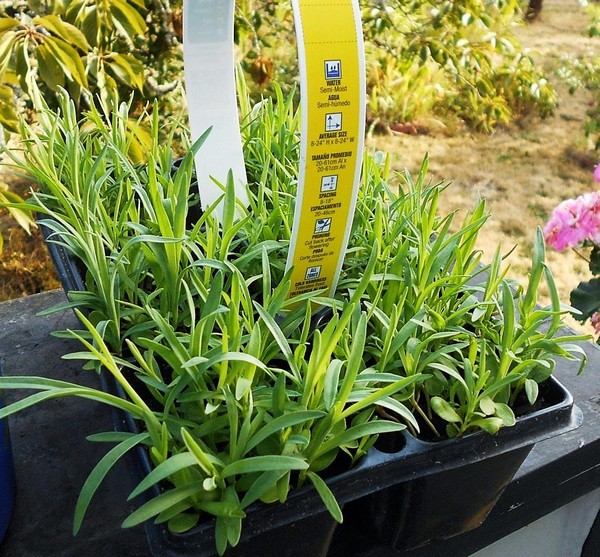
Sowing seeds in open ground
When growing Grenadine carnations from seeds immediately in the open field, you must:
- Prepare the beds. The soil on them should be loose, nutritious and have good water permeability. It is allowed to mix the land on the site with river sand.
- It is recommended to sow seeds in a brightly lit area or in an "openwork" shade. Sowing is carried out in the month of May or in mid-June - it all depends on the region.
- We embed the seed to a depth of about 1 cm, pour a small layer of substrate on top and crush it a little. We must moisten the garden bed.
- In order to maintain optimal humidity in the upper layer of the earth, we cover the crops with agril.
The first shoots will appear in about 7-10 days. At this time, the shelter must be removed. A month later, when the young plants are strong enough, they are transplanted for growing. In this case, the rows in the bed are located at a distance of about 15 cm from each other, between the holes - at least 6 cm.We dive young carnations and make a canopy over them, which will protect the seedlings from direct sunlight. As soon as the bushes begin to grow actively, we remove the canopy.
In August, mature plants can be moved to a flower garden. In the first year of its life, the Grenadine carnation forms compact bushes about 9-10 cm high and up to 15 cm wide. At the same time, developed plants can have up to 100 vegetative shoots. In the second year - around the month of June or June - the buds on the stems will begin to bloom. Mass flowering in this case will last for a month, and the general flowering - up to 60 days.
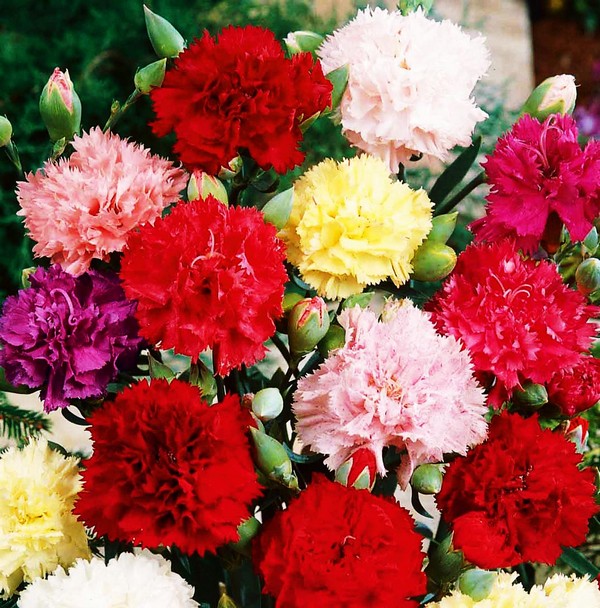
Growing Chinese carnation seedlings at home
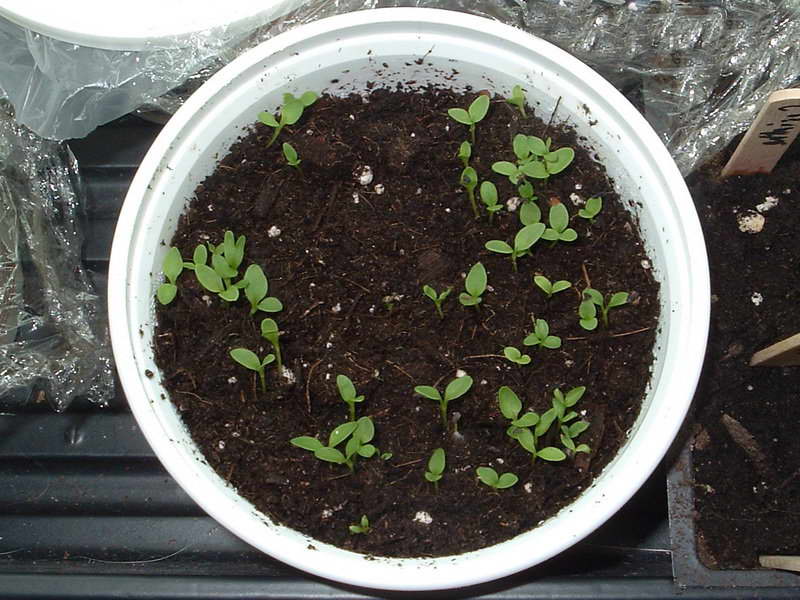
Chinese carnation seed cultivation photo shoots
Start sowing Chinese carnations for seedlings in late February and early March (some flower growers recommend sowing from January if it is early spring in your region). You will need a container or any wide container. Lay any drainage at the bottom, fill it with a universal substrate for growing seedlings or prepare it yourself: garden soil with the addition of sand and vermiculite.
- Spread the seeds over the soil surface, sprinkle with vermiculite (it promotes seed germination), spray with a fine spray.
- Place the container with crops on a light windowsill, maintain the air temperature at 20 ° C, the soil should be constantly moist. The foil does not need to be covered.
- When the sprouts appear, the temperature will need to be lowered to 15-17 ° C so that they do not stretch out.
- After the appearance of two true leaves, plant the sprouts in separate containers, where the seedlings will continue to grow until they are transplanted into the open ground.
- When the plants grow up, pinch the tops, leaving 4 true leaves, and the higher, cutting with scissors. This will provoke the growth of side shoots and allow you to get powerful bushes with abundant flowering.

Seedlings of Chinese carnation as the photo looks
It is possible to transplant into the ground when the threat of recurrent frost has completely passed. Plants by this time can already throw out color. A week before planting, harden the seedlings - first take them out into the garden for several hours, then increase the length of time until the seedlings are able to spend the night outside.
Transplant by transshipment of an earthen coma. The lune must be of the appropriate size for this. The root collar is flush with the soil surface.
Disease and pest control
When growing carnations, watering and feeding alone will not be enough. All cultivated plants are subject to various diseases and pests, so if you want to decorate the site with bright colors, you must follow simple but very important rules for caring for the plant. This will protect the carnation from aphids, ticks, rot and other annoyances. As noted earlier, an excess of nitrogenous mineral fertilizers or waterlogging of the soil are the main causes of the appearance of the fungus. To prevent this from happening, constantly monitor the condition of the soil. If necessary, it must be fertilized and loosened.

Fungus spores on the foliage of a perennial carnation
With the arrival of winter, pest control intensifies. For the winter, cloves must be treated with special pesticides purchased from a garden store. These drugs include "TMTD" - it will protect plants from rodents. For the winter period, the carnation needs to be covered with spruce branches, which does a good job with its task. But, in addition to spruce branches, snow should be tamped tightly around the carnation - this is necessary for safety net.

Warming with fir branches (spruce branches) for the winter
Also, a new problem arises before gardeners: in the winter, the Grenadines can not only freeze, but also overheat. In addition, a spruce spruce branch removed at the wrong time can lead to sunburn on the plant.
Sowing and growing carnations at home
Sowing and caring for a plant at home is not difficult for gardeners. Therefore, many plant it in their apartments.
To obtain healthy seedlings, you need to take seedling boxes with soil - cloves like a sandy loam or sandy variety with a slightly acidic or neutral reaction
It is very important to ensure drainage
Expanded clay, zeolite or even foam cut into pieces are suitable as drainage.
The soil in the boxes is moistened and furrows are made, keeping a couple of centimeters between them. Seeds are sown not very often and sprinkled on top with the same soil. After that, the box is closed with glass or placed in a plastic bag, placed in a room where the temperature is constantly maintained at +24 degrees.
The sown plant must be monitored, removing the resulting condensation. When shoots appear, the shelter is removed and a light source is placed above the box. It is better to cover the cloves at night so that they do not suffer from temperature changes.
Water the flower carefully, trying not to overdo it. Plants are planted after the formation of several true leaves
It is advisable to harden the carnation.
If the carnation grows in a pot at home, there is nothing difficult to care for. It is enough to provide the plant with water in a timely manner, loosen the soil, apply fertilizers and cut. When the bush has faded, the stunted flowers are cut off along with the upper part of the stem (up to five centimeters). The carnation will bloom again after a period of time.
Transfer to a permanent place
For normal growth, a carnation needs a permanent place, because it is a perennial plant. It is advisable to start the transplant in the second half of July, but not later than the first days of August. If you start transplanting even a few weeks later, the plant will not be able to root normally, which will make it a real challenge for it overwintering.
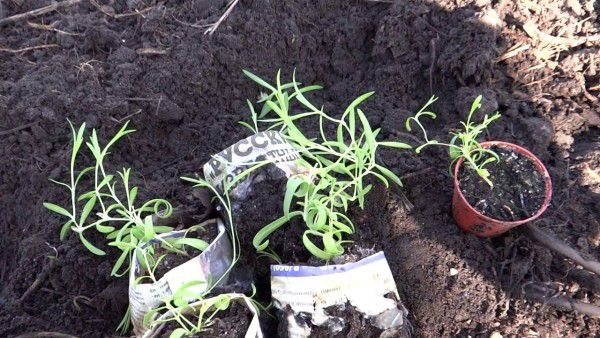
Planting carnation seedlings
Important! You need to plant carnations at a decent distance from each other (at least 35 cm), because this plant needs a lot of space. First you need to prepare the soil and water it well.
Before watering, it is necessary to add special fertilizing to the holes, consisting of mullein, humus and peat. All ingredients are added in the same amount
First you need to prepare the soil and water it well. Before watering, it is necessary to add special fertilizing to the holes, consisting of mullein, humus and peat. All ingredients are added in the same amount.
Over time, the plant should take root. When this happens, carefully loosen the soil, being careful not to damage the roots of the carnation. If it is very hot outside, then the soil needs to be watered again.
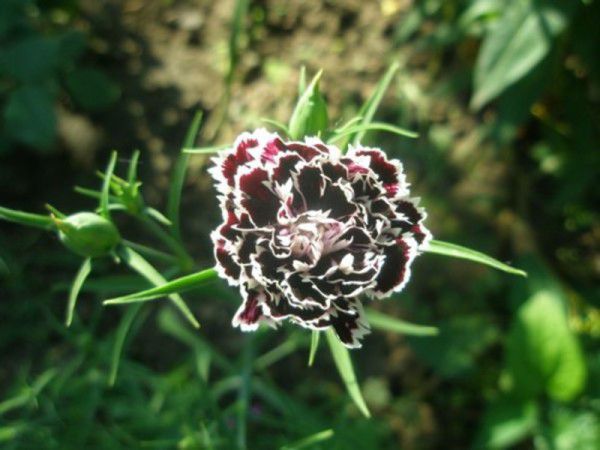
Varieties
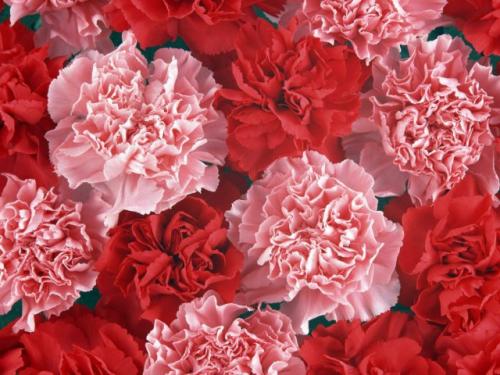
Currently, many amazing varieties of grenadine cloves have been bred. Among them:
- Gloria with red double flowers.
- Rose Kenigin is distinguished by its terry, aroma of bright pink inflorescences.
- Kening des Gelben attracts flower growers with bright yellow flowers.
- Schneeflokke has snow-white flowers.
- Russian scientists can be proud of the Northern Lights, Coral, Carrot King, Rose.
Carnation Grenadine in the second year reaches a height of 50-60 cm. There are a lot of flowers on it, about 200 pieces. To get a lush bush, pinch the upper shoot for the appearance of side shoots. When they grow up to 20 cm, they need to be pinched again to make the bush even more lush.
The same is done with Turkish cloves and shabo.
Whichever variety of carnations you choose, they have the same growing method. So there is no need to reinvent the wheel, work with grenadine cloves the same way you do other varieties.
In order for a carnation to bloom for a long time and delight with its lush buds, you do not need to leave the first flowers on the bushes. They must be cut off.
To obtain your own seeds, you should select double flowers. If there are few flowers on the bushes, then artificial pollination can be used.Deltoid and Alpine carnations are distinguished by the largest number of seeds.
How to grow a shabo carnation, see the advice of an experienced gardener in the following video:
Carnation is perhaps one of the most common types of flowers among gardeners and summer residents. The plant is quite unpretentious in care, however, for its successful cultivation, you still need to know some of the nuances. Therefore, further we will get acquainted with the features of planting and caring for garden carnations.
Planting and care in the open field
Several methods can be used to propagate perennial carnations. It depends on the selected variety and the capabilities of the grower.
Seed propagation
One of the most common breeding methods for garden perennial carnations is growing seedlings from seeds. This method allows you to get a plant of the desired variety without much labor.
You can start sowing from the end of February. The process of growing seedlings can be divided into several stages:
Soil preparation and containers
Sowing soil should be light and nutritious. To prepare it, you should mix garden soil with three parts of sand, two parts of compost and one part of peat. The container and the prepared soil must be disinfected. For this, either treatment with a solution of potassium permanganate or disinfection by calcining is used.
Seed preparation
First of all, you need to decide on the variety. After the selection is made, the seeds should be soaked in a weak manganese solution for disinfection.
Sowing
Clove seeds should not be buried in the ground. They are sown on the soil surface and sprinkled on top with a small amount of sand.
Next, the container is covered with film or glass and kept at a temperature of at least 18 degrees in a dark room. After the emergence of seedlings, the seedlings are moved to the lightest window sill.
Important! Young seedlings require a lot of light for full growth. If there is not enough sunlight, it is imperative to supplement the seedlings
This will avoid stretching and loosening the shoots.
A month later, when the plants grow up, they need to be opened and pinched off the top.
Propagation by cuttings
If possible, you can get a new copy of the plant of the desired variety by cuttings. This method allows you to speed up the breeding process and achieve flowering already in the year of planting.
Cuttings are suitable for propagation of carnations
They start harvesting cuttings in late May or early June. For this, a healthy shoot is used, which has 3-4 leaves. The lower leaves should be removed.
Attention! Before planting, prepared cuttings are recommended to be treated with a special preparation to stimulate root growth. Next, the processed cuttings are buried in the prepared soil.
It is better to choose a light, sandy soil. It should also be moistened before planting. If all the conditions were met, after 2-3 weeks a root system is formed and the seedlings start growing
Next, the processed cuttings are buried in the prepared soil. It is better to choose a light, sandy soil. It should also be moistened before planting. If all the conditions were met, after 2-3 weeks a root system is formed and the seedlings start growing.
Dividing the bush
This method also applies to perennial carnations. But it cannot be used for all varieties of this plant. In some species, the root system has one core and it is not possible to divide such a bush.
To obtain a new plant in spring, the bush is completely dug up and divided into two or more parts. Then, obtained as a result of division, the plants can be transplanted into the ground to a permanent place.
Care of young plants
Young seedlings for full development should be provided with full care. Care should be taken to ensure that the soil does not dry out. At first, young plants constantly need moisture.
Seedling carnation
The tops of the plant should be pinched. This will strengthen the branching of the shoots and prevent the seedlings from stretching.
You should also pay attention to loosening the soil and weeding it from weeds. Before the onset of cold weather, plantings should be covered
Young, not matured, plants may not tolerate severe frosts. Overwintering without shelter can lead to plant death.
Before the onset of cold weather, plantings should be covered. Young, not matured, plants may not tolerate severe frosts. Overwintering without shelter can lead to plant death.
Planting seedlings in the ground
You can start planting seedlings in the ground only after the threat of frost has passed and the soil is sufficiently warmed up. As a rule, this is mid - end of May. But for some regions, the dates may be later, given the peculiarities of the climate.
Before you start planting ready-made seedlings, you should decide on the landing site. This perennial prefers sunny places. The soil must be prepared depending on the exactingness of the selected variety. Some species prefer nutritious soil, and for some varieties, poor rocky soils are enough.
Preparation of medicinal raw materials
All parts of the plant are used as medicinal raw materials: roots, stems with leaves, flowers and seeds.
Dig up the roots with a garden shovel, remove the soil and rinse well under running water. Then blot with a napkin or towel. Cut into small pieces, spread in a thin layer on a newspaper or a special mesh to dry. Dry in a shaded place with good ventilation (attic, canopy, i.e. out of access to moisture). Can be quickly dried in an oven at 45-50 ° C.
Place the dried raw materials in fabric bags and store for two years. After the expiration date, it makes no sense to apply - the medicinal effect is lost, replace with fresh raw materials.
Harvest the aerial part (stems, leaves, flowers) in dry weather in the daytime (after the dew has melted). Cut the stems almost to the root. Separate the flowers and dry them separately, similar to the roots (on a net or dry bedding, spread out in a thin even layer). The stems can be bunched and hung to dry. Store such raw materials in cloth bags or paper-cardboard boxes for no more than one year.
Collect seeds during their ripening period. Pour gently from the capsule fruit. Store in paper bags. Seeds remain viable for 4-5 years.
Shabo carnation at home
Many enthusiastic growers are happy to grow Shabo carnations at home. Since the hybrid is a perennial, the plant feels great in an apartment and blooms profusely. The main condition is to water on time, feed often (you can every two weeks) and provide good ventilation.
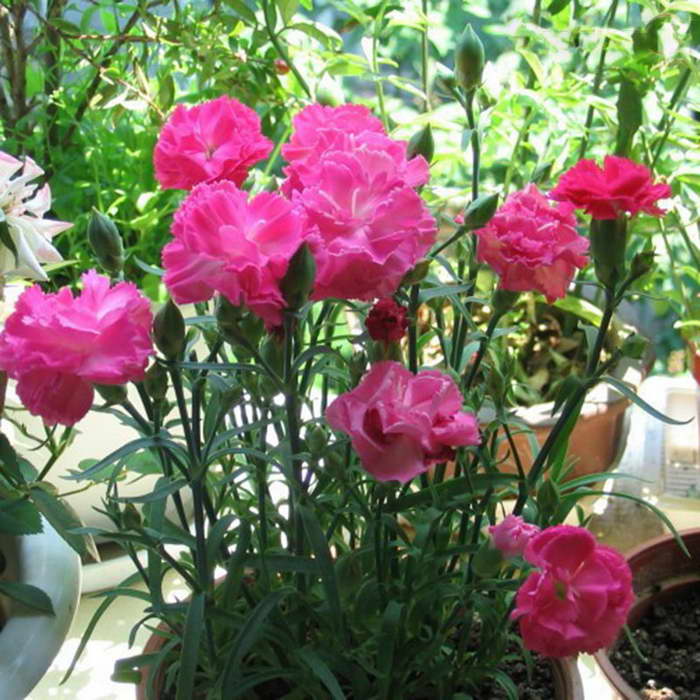
Carnation Shabo at home how to care
Carnation Shabo prefers low temperatures up to 24 ° C and long daylight hours. In winter, the plant can be provided with a dormant period, starting in September. To do this, reduce watering and move the beauty to a cold place with a temperature of 12-14 ° C. In February, they return to the light warm windowsill and begin to water and feed abundantly. The beauty immediately sprouts new shoots and flower buds.
After 4-5 years, the bush will begin to age, but it does not matter: you can use its shoots for grafting or re-sow seeds for seedlings.
Open ground preparation
For good adaptation of seeds in the ground, if it is decided to immediately sow in open ground, you need to prepare the site.
The soil is pretreated:
- The beds are distributed on loose, nutritious and permeable soil.
- To improve the characteristics, river sand, a layer of turf with peat are added and mixed.
- The upper layer of the soil area is watered with potassium permanganate, diluting the crystals in water to a faint pink color, the solution will destroy harmful microorganisms.
The site is chosen illuminated, slight shading is allowed. Sowing begins at the end of May or June, depending on the weather conditions in the region.
The farmer should take into account that waterlogged soil:
- adversely affects the decorative quality of grenadine;
- does not allow all the virtues to be fully revealed;
- develops diseases;
- leads to the death of the sprout.
Dry soil is also not suitable, you need to choose a useful middle and slightly moisten the soil before sowing.
Description of the plant
Carnation Grenadine is a striking representative of the garden Carnation species. Its homeland is the Mediterranean, where in natural conditions this culture grew like a perennial. Now, under the conditions of the climate of our country, this flower is grown as a biennial plant, and the most abundant flowering and intensive seed formation occurs in the second year of its life.
Plant height ranges from half a meter to 70 cm. Leaves are linear, sitting oppositely on a straight thin knotty stem. Their color is green with a bluish tinge. The leaves on the stem are partially distributed in rosettes, their diameter reaches 30 cm.
During the flowering period, flowers appear at the ends of the shoots, and there can be several of them on one stem. The diameter of one flower is about 3-5 cm. Depending on the varietal accessory of the carnation, Grenadine can produce double, semi-double and non-double flowers. The edges of the petals are also different: with a solid or finely toothed edge.
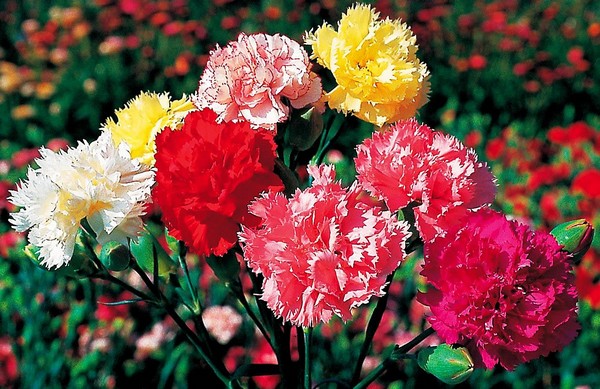
After flowering, in place of fragrant flowers, fruits are formed - multi-seeded capsules. The seeds are very small and in one gram alone there can be about 600 pieces.

